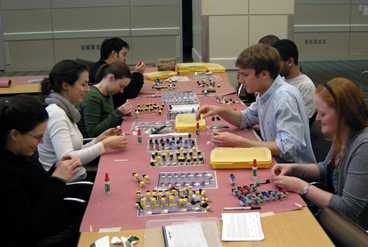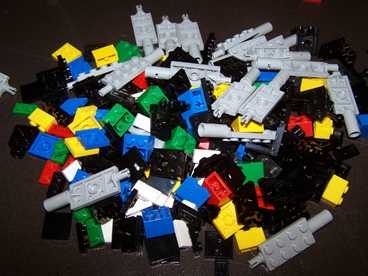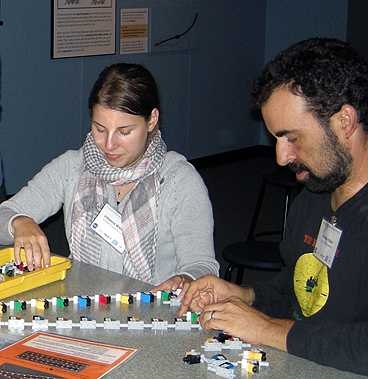Surrounded by thousands of individual, multicolored LEGO bricks, MIT sophomore Jean Fang was undaunted — even though all of those pieces needed to be sorted, assembled and labeled into biology kits for local schools.
In charge of the Alpha Chi Omega (AXO) freshman pledge class, Fang had brought her class out to help assemble LEGO classroom kits, which contain thousands of LEGO bricks in subunits representing parts of DNA and RNA and protein molecules. Fang's pledge class was one of many groups and individuals from MIT who are helping to sort and assemble the 190,000 bricks into molecular subunits, which in turn must be labeled, checked, glued, packed into kits and organized into the classroom sets.
“I thought this was a good way to get the class together," Fang said. "Science education is obviously important for us at MIT, and the activity is definitely fun.”
And the end result of the groups' hard work: a unique and interactive learning tool for the Boston Public Schools.
"Dynamic LEGO models help students learn cellular processes while they complete the steps to building a protein. Their hands do all the work, while their minds are constantly making decisions about what happens next. It's a very active form of learning," said Dr. Kathy Vandiver, outreach director for MIT’s Center for Environmental Health Sciences and inventor of the LEGO Life Science molecules.
Calculating that 122 person-hours will be needed to create each classroom’s LEGO DNA Learning Center Set, and that 10 sets will be built, Vandiver contacted Lori Tsuruda ’89, founder and executive director of the non-profit People Making a Difference (PMD). This charity organizes and advertises hands-on opportunities for volunteers to its e-mail list, website and Facebook page, where individual volunteers can sign up for the projects that interest them and fit their schedules. Freshman Rachel Keeler, of Alpha Phi Omega (APO), an MIT service fraternity, is currently coordinating the LEGO project work with Tsuruda and Vandiver.
Tsuruda noted how the work reflects on MIT's history of public service.
“This particular volunteer service is a perfect way to commemorate MIT's 150th anniversary,” Tsuruda said.
Putting the pieces together
During Fang's building session, the pledge class busily assembled RNA nucleotides from LEGO diagrams, after counting out and distributing 240 component parts into each of the 140 RNA boxes. In the next step, additional volunteers check and permanently glue together the units and then attach a label to identify each of the units as A, U, C or G nucleotides.
Across the room, a group of women from Partners HealthCare and their three middle-school-age sons diligently worked on their LEGO RNA. They had independently learned about the event from PMD volunteer Barbara Corning-Davis GM ’01, and signed up to socialize with friends from work while helping out a good cause.
After attending training classes through MIT's Center for Environmental Health Sciences (CEHS) outreach program and the Department of Aeronautics and Astronautics, 20 Boston Public School science teachers will introduce the LEGO DNA Learning Center kits in their classrooms this spring. The LEGO molecular biology unit includes a teacher guide and PowerPoint slides, student booklets, handouts, posters and movies.
A NASA “Summer of Innovation" grant to the MIT Edgerton Center funded the LEGO bricks, the teacher professional development workshops and the student internship. A Massachusetts Service Alliance grant to People Making a Difference funded its volunteer mobilization efforts during Martin Luther King Jr. week.
Additional LEGO-building volunteer groups in January and February include Eugene Wright Middle School students from Chelsea; sixth graders from the Winsor School; AMITA; BAMIT; MIT Club of Boston; MIT-Harvard HST Program; MIT fraternities Kappa Sigma and Zeta Beta Tau; MIT Hillel; and faith-based groups from New England; MIT Bioengineering Graduate Students; Bunker Hill Community College; Harvard Black Student's Association; and Harvard Society of Black Scientists & Engineers.
Help from adult members of the MIT community is still needed on Wednesday, Feb. 23. Register yourself by Feb. 16 to help check and glue Lego units 12:30-2:30 p.m. or 3-6 p.m., or register by Feb. 13 to help from 6:30-9 p.m. If your group of 20 or more is interested, please e-mail lori@pmd.org to schedule.
MIT groups lending a hand by assembling LEGO biology kits for local schools.
Publication Date:

Caption:
Eight MIT biological engineering graduate students volunteered for a three-hour shift on the evening of Jan. 20. They glued the amino acid side chain structures together for the LEGO protein kits.
Credits:
Photo: Kathleen Vandiver

Caption:
The pile of LEGO components used to make LEGO DNA.
Credits:
Photo: Lori Tsuruda

Caption:
Two lead Boston Public School biology teachers, Johanna Waldman and Andrew Rabin, attended the teacher professional development workshop at MIT in October 2010.
Credits:
Photo: Kathleen Vandiver





